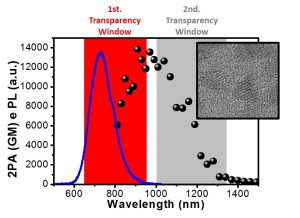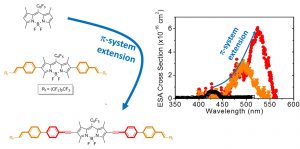
PL (continuous line) and 2PA (scatter) for a sample of pyramidal shaped CuInS2 QDs plotted over the biological tissue transparency window.
Materials exhibiting high optical nonlinearities are of interest for a number of applications, including optical communications and biophotonics. Furthermore, nonlinear spectroscopy can be an useful tool to understand materials electronic properties because it may allow us to access optical transitions which are forbidden by linear absorption methods. In our group, we are mostly interested in investigating cascaded first order nonlinearity, such as saturable absorption and excited state absorption, and third order processes, two-photon absorption and nonlinear refractive index. We use nonlinear optical studies to understand the relations between structural properties and nonlinear optical response, which can guide the development of novel optical materials with tailored nonlinear optical response.
Among the investigated systems, we focus our studies in ternary semiconductor quantum dots (CuInS2 or AgInS2), novel engineered heterostructures and conjugated molecules. In all of those systems, using nonlinear optical spectroscopy, we can interrogate optical transitions which are weak or even forbidden by linear spectroscopy, giving a more complete picture of their electronic structures, helping to guide the development of optimum nonlinear optical materials.

Changing the excited state absorption by modifying the molecule conjugation length in BODIPY dyes
In particular, ternary quantum dots are of great interest because their composition are free of heavy metals (Pb or Cd), drastically reducing their toxicity. Additionally, they exhibit a series of peculiar properties, such as large Stokes shift, long lived photoluminescence, and broadband emission tunability. Understanding their nonlinear optical properties can open possibilities for their application as bio-labels.
